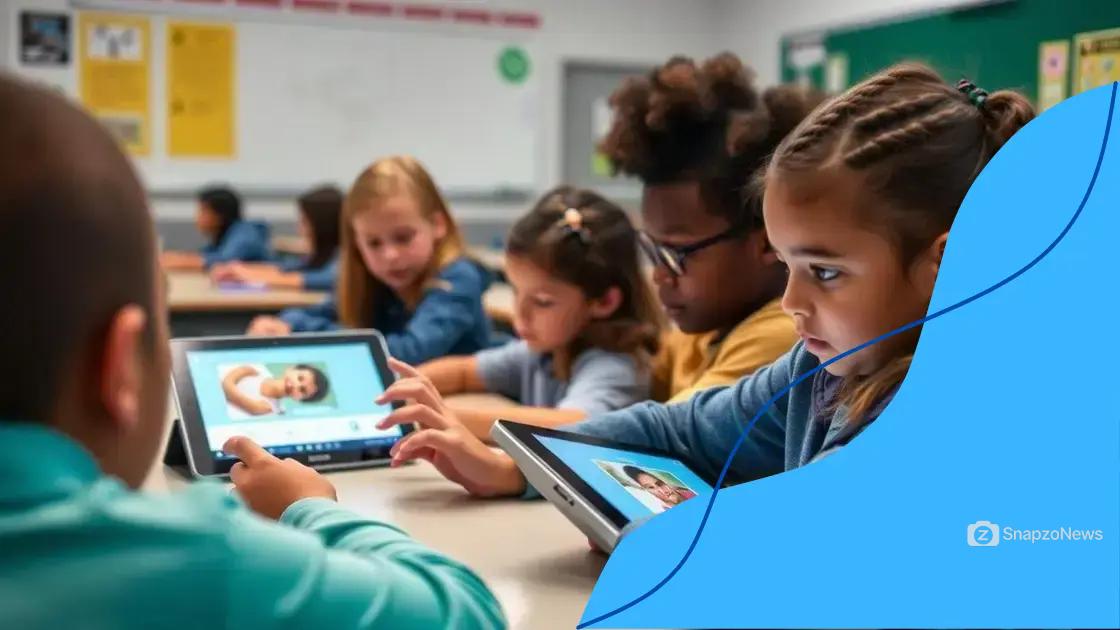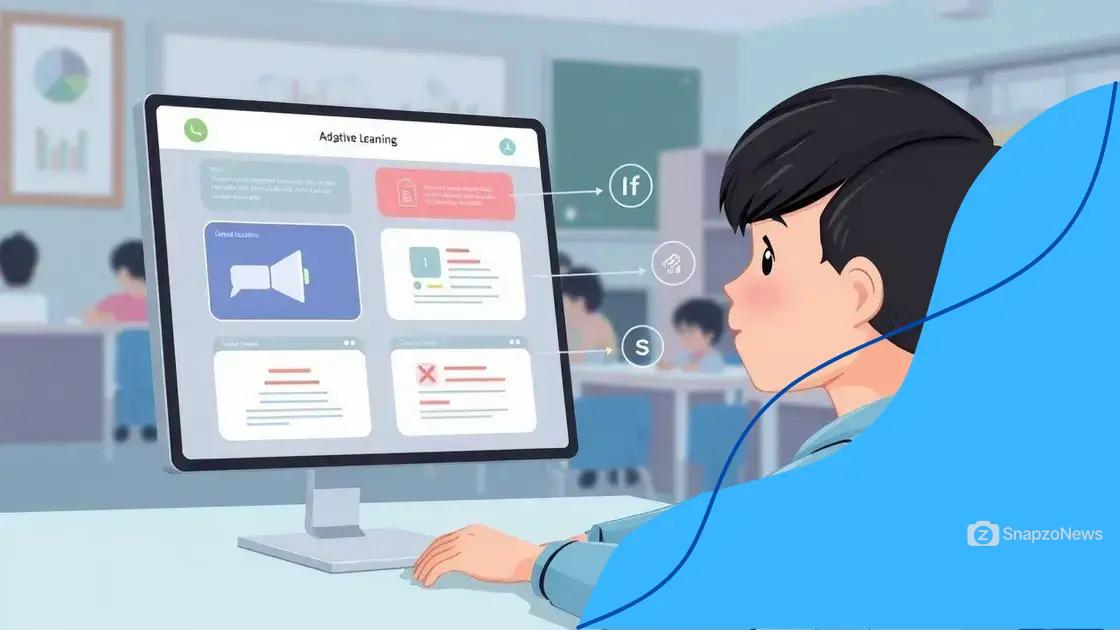The role of artificial intelligence in personalized learning

The role of artificial intelligence in personalized learning enhances educational experiences by tailoring content to individual student needs, improving engagement, and providing real-time feedback through advanced technologies.
The role of artificial intelligence in personalized learning is changing how we approach education. Imagine a classroom where each student’s needs are met individually. Wouldn’t that make learning more effective and enjoyable?
Understanding personalized learning
Understanding personalized learning is essential in today’s educational landscape. As classrooms become more diverse, the need for approaches that cater to individual students grows. This method focuses on tailoring education to meet each student’s unique needs and strengths.
The key elements of personalized learning
To fully grasp this concept, one must consider several fundamental elements that work together to create a tailored educational experience.
- Flexibility: Students progress at their own pace, ensuring they master concepts before moving on.
- Student autonomy: Learners have a voice in their learning paths, allowing them to choose topics and projects that interest them.
- Data-driven insights: Teachers use assessment data to monitor progress and make informed decisions about instruction.
- Collaborative environments: Students often work together, fostering communication and teamwork skills.
Each of these components contributes to a more engaging and effective educational experience. For instance, a student struggling with math can take extra time on specific topics while advancing quickly in areas of strength, like reading. This approach enhances motivation and reinforces learning.
How technology enhances personalized learning
Technology plays a vital role in facilitating personalized learning. Tools such as learning management systems and educational apps allow for a more individualized experience. These tools can adjust content based on a student’s performance, providing targeted practice opportunities.
Moreover, artificial intelligence (AI) can analyze student data to provide real-time feedback. This support helps teachers identify where students might need additional help, ensuring effective interventions. By combining technology with personalized strategies, educators can create a rich learning environment that keeps all students engaged and on track.
Ultimately, understanding personalized learning is about recognizing that each learner is unique. Education should not be one-size-fits-all; instead, it should embrace the diversity of students and their learning paths.
Benefits of artificial intelligence in education
The benefits of artificial intelligence in education are transformative. Schools and educators are increasingly recognizing how AI can enhance learning experiences and improve outcomes for students. This technology provides tools that can adapt to individual learners and streamline administrative tasks.
Personalized learning experiences
One of the most significant advantages of using artificial intelligence is its capability to offer personalized learning. AI algorithms can analyze data from students’ interactions and performance, helping create tailored learning paths. This means that each student can receive instruction best suited to their abilities and preferences.
- Adaptive assessments: AI can adjust quizzes and tests to match a student’s current level, ensuring each learner is challenged appropriately.
- Targeted feedback: Immediate feedback from AI tools helps students understand their mistakes and learn from them right away.
- Custom learning materials: AI can curate resources and materials that align with each student’s interests, making learning more engaging.
- Developing critical thinking: With the right guidance, AI encourages students to think critically and solve problems creatively.
Moreover, artificial intelligence can aid teachers by managing administrative workloads. By automating tasks such as grading and attendance tracking, educators can spend more time in the classroom focusing on teaching instead of paperwork.
Enhanced engagement and motivation
Engagement plays a crucial role in effective learning. AI tools can incorporate gamification elements that make learning fun and interactive. For instance, adaptive learning platforms often use point systems or rewards to motivate students. This not only enhances enjoyment but also encourages persistence, as students are eager to overcome challenges.
Also, AI can provide real-time analytics to teachers, indicating how each student engages with the content. This data is invaluable for adjusting lessons and ensuring no one falls behind. By understanding students’ needs, teachers can foster a classroom environment that thrives on collaboration and mutual growth.
How AI tailors learning experiences

AI tailors learning experiences in remarkable ways that benefit both students and teachers. By analyzing vast amounts of data, artificial intelligence can customize educational content to fit individual student needs. This means that each learner receives a unique educational experience based on their learning styles and abilities.
Adaptive learning platforms
AI powers adaptive learning platforms that adjust the difficulty of tasks in real time. For instance, if a student excels in math but needs more time in reading, the platform will offer challenging math problems while providing additional reading exercises. This targeted approach ensures that students spend their time on what they truly need.
- Customized learning paths: Students follow personalized paths tailored to their strengths and weaknesses.
- Individual pacing: AI allows learners to progress at their own speed, eliminating frustration from a one-size-fits-all approach.
- Data-driven insights: Teachers gain insights into student performance, making it easier to intervene when necessary.
- Engagement boosters: AI can use gamification to make learning more enjoyable.
In addition to providing personalized tasks, AI can also curate content that aligns with students’ interests, making lessons more engaging. If a student loves space, the platform might include astronomy-related materials in science lessons. This connection keeps students motivated and eager to learn.
Real-time adaptations and feedback
Furthermore, AI offers real-time feedback that is crucial for effective learning. Students can receive instant responses to their actions, helping them understand mistakes immediately. This feedback loop reinforces learning and helps to correct misunderstandings right away.
By using AI to tailor learning experiences, educators create a supportive environment where all students can thrive. This technology’s ability to adjust lessons based on performance means that no student is left behind, ultimately leading to better educational outcomes.
Challenges in implementing AI in learning
Implementing artificial intelligence in learning comes with various challenges that educators and institutions must address. While AI offers tremendous potential, navigating its integration into existing educational systems is not always straightforward. These challenges can affect both teachers and students.
Technical complexities
One of the significant challenges is the technical complexity associated with AI systems. Developing and maintaining these systems require advanced skills that many educators may not possess. Furthermore, schools need to ensure that their infrastructure can support AI technologies, which can involve substantial financial investment.
- Hardware requirements: Robust hardware is necessary for effective AI tools, and budget constraints can limit access.
- Software integration: Integrating AI solutions with current educational software can be difficult and time-consuming.
- Training needs: Teachers require ongoing training to effectively use AI tools in their classrooms.
- Data management: Managing student data ethically and securely is critical.
As the technical landscape continues to evolve, educators must keep pace with these changes. They must be prepared to learn new skills to leverage AI effectively.
Equity and access issues
Another challenge involves equity and access. Not all students have the same level of access to technology, creating disparities in learning opportunities. Some students may not have reliable internet at home or access to the necessary devices. This inequality can lead to a digital divide that hinders the effectiveness of AI in education.
Addressing these access issues is essential for successful AI implementation. Schools need to find solutions to ensure all students can benefit from personalized learning experiences. This may involve providing devices and internet access to disadvantaged students.
Moreover, teachers may face resistance from stakeholders who fear that AI could replace traditional teaching methods. Maintaining the human element in education is crucial, and teachers are concerned about how AI will change their roles.
Future trends in AI and education
Future trends in AI and education are exciting and can significantly change the way students learn. As technology evolves, the integration of AI in classrooms will become more sophisticated, leading to enhanced educational experiences. These advancements are set to create new opportunities to support teachers and empower students.
Increased personalization
One major trend is the increased level of personalization in learning. As AI becomes more advanced, it will gather even more data about each student’s preferences, behavior, and learning style. This will lead to highly personalized content that fits each student’s needs perfectly, catering to their strengths and weaknesses.
- Learning analytics: AI systems will analyze student data more deeply to predict future challenges and tailor resources accordingly.
- Customized curriculums: Educators will have tools to create customized curriculums that adapt as the student progresses.
- Enhanced resources: AI will help in creating interactive and engaging learning materials that reflect current trends.
- Comprehensive support: Students will have access to AI-driven tutoring that provides assistance outside of traditional classroom hours.
As AI continues to evolve, it will help bridge the gap between different learning styles, making education more effective for everyone.
Integration of virtual and augmented reality
Another exciting trend is the integration of virtual reality (VR) and augmented reality (AR) with AI. These technologies can create immersive learning experiences that make complex subjects easier to understand. For example, students can take a virtual field trip to ancient civilizations or conduct interactive science experiments without leaving the classroom.
This hands-on approach makes learning more engaging and enjoyable. Students can explore and interact within these digital environments, leading to deeper understanding and retention of information.
Moreover, AI can help educators track student progress in virtual settings. Teachers will be able to gauge engagement levels and adjust lessons as needed, further enhancing the learning experience. As these technologies become more accessible, the classroom of the future will be a dynamic learning environment.
FAQ – Frequently Asked Questions about Artificial Intelligence in Education
How does artificial intelligence personalize learning experiences?
AI analyzes student data to tailor educational content to individual needs, ensuring that each learner receives the appropriate level of challenge and support.
What makes AI beneficial for teachers?
AI helps educators by automating administrative tasks, providing data-driven insights into student performance, and offering personalized resources to enhance the learning experience.
Are there challenges in implementing AI in classrooms?
Yes, challenges include technical complexities, equity and access issues, and the need for teacher training to effectively use AI tools.
What are future trends in AI and education?
Future trends include increased personalization, integration of virtual and augmented reality, and innovative teaching methods that leverage AI for enhanced engagement.
